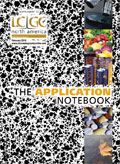EDTA by Anion Exchange HPLC
Hamilton Company is best known for manufacturing precision fluid measuring products, including syringes for HPLC and GC.
Hamilton Company is best known for manufacturing precision fluid measuring products, including syringes for HPLC and GC. For the last 30 years Hamilton Company has manufactured HPLC resins and columns while developing separations for customers. Two of the separations are highlighted below.
EDTA is a chelating agent added to processed foods, pharmaceuticals, soaps, cosmetics, textiles, and household cleaners. An HPLC method was needed for the determination of EDTA in a company's product. A search of the literature turned up a few references for the separation of EDTA on reversed phase columns. These methods required the use of ion pairing reagents or amperometric detection. Hamilton's goal was to develop a method that utilized a simple mobile phase, easy sample preparation, and UV detection.
Experimental Conditions
HPLC Column: Figure 1, PRP-X100 anion exchange, 10 μm spherical particles, 4.6 × 150 mm (PEEK) (Part Number 79354). Figure 2, PRP-X100 anion exchange, 10 μm spherical particles, 4.1 × 250 mm (stainless steel) (Part Number 79433).

Figure 1: Hydrocortisone cream. PRP-X100, 10 μm, 4.6 à 150 mm, PEEK (Part Number 79354). Conditions: 70:30 3 mM sulfuric acid:methanol; 100 μL injection; 2 mL/min; isocratic; ambient; UV at 254 nm. Peak 1 = EDTA copper complex.
Mobile phase: In Figure 1, hydrocortisone cream, a 30:70 3 mM sulfuric acid:methanol mobile phase was used for two reasons. First, the 3 mM sulfuric acid provided a strong driving ion to elute the EDTA copper complex in less than 3 min. Second, methanol is a strong enough solvent to elute the hydrophobic compounds present in the hydrocortisone cream. In Figure 2, nasal spray, a 65:35 1.5 mM sulfuric acid:methanol mobile phase was used.

Figure 2: Nasal spray. PRP-X100, 10 μm, 4.6 à 250 mm. (Part Number 79433). Conditions: 65:35 1.5 mM sulfuric acid:methanol; 100 μL injection; 1.5 mL/min; isocratic; ambient; UV at 254 nm. Peak 1 = EDTA copper complex.
Detection Method: The detection method was chosen because of simplicity. UV detection at 254 nm is easy to use, with good sensitivity.
Detector: Milton Roy SpectraMonitor 3100 variable-wavelength UV detector.
Sample Preparation and Injection Size
In Figure 1, 8 g of cream was dispersed in 100 mL of deionized water. Four milliliters of this solution was mixed with 6 mL of 0.05 M cupric sulfate. This solution was filtered and 100 μL was injected into the column.
In Figure 2, 4 mL of nasal spray was mixed with 6 mL of 0.05 M cupric sulfate. This solution was filtered and 100 μL was injected into the column.
Results
The use of the PRP-X100 anion exchange column allows the rapid quantitation of EDTA. The sulfuric acid mobile phase works well in these applications, as no interferences are seen. Organic solvent compatibility from 0 to 100% allows samples containing hydrophobic compounds to be analyzed with simple dilute, filter, and shoot methods. In Figures 1 and 2 the hydrophobic compounds elute at the column void.
Conclusions
For this application it was possible to improve upon the published methods and meet our goal of a robust method that utilizes a simple mobile phase, easy sample preparation, and UV detection.
For more information about Hamilton HPLC columns, contact the Hamilton Company or visit our website.

Hamilton Company
4970 Energy Way, Reno, NV 89502
tel. (800)648-5950; (775)858-3000; fax (775)856-7259)
Website: www.hamiltoncompany.com/hplc

SEC-MALS of Antibody Therapeutics—A Robust Method for In-Depth Sample Characterization
June 1st 2022Monoclonal antibodies (mAbs) are effective therapeutics for cancers, auto-immune diseases, viral infections, and other diseases. Recent developments in antibody therapeutics aim to add more specific binding regions (bi- and multi-specificity) to increase their effectiveness and/or to downsize the molecule to the specific binding regions (for example, scFv or Fab fragment) to achieve better penetration of the tissue. As the molecule gets more complex, the possible high and low molecular weight (H/LMW) impurities become more complex, too. In order to accurately analyze the various species, more advanced detection than ultraviolet (UV) is required to characterize a mAb sample.

.png&w=3840&q=75)

.png&w=3840&q=75)



.png&w=3840&q=75)



.png&w=3840&q=75)














